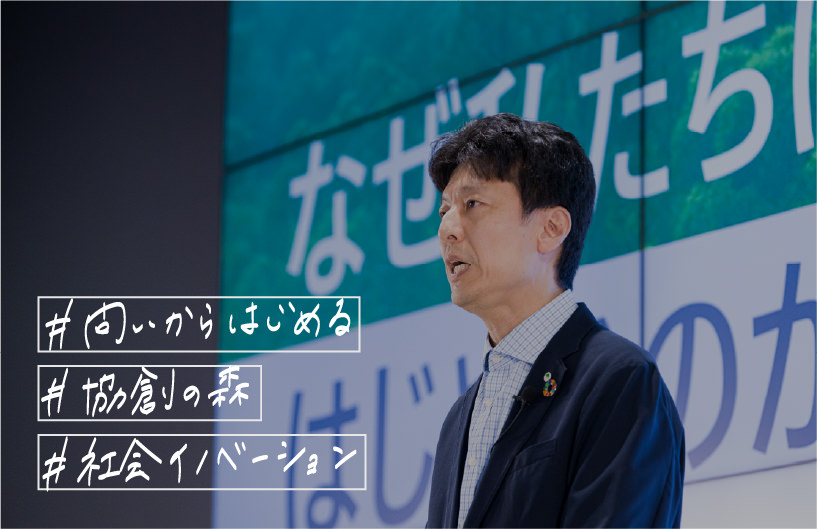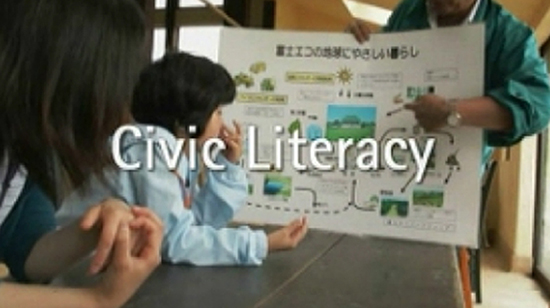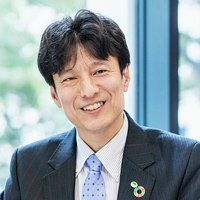(October 7, 2021)

With so many social issues now abounding on a global scale, any efforts by companies to solve corporate issues will be expected to be either directly or indirectly linked to social innovation. So what should we be looking at and what question should we be asking as we seek to pursue social innovation?
Masakatsu Mori, General Manager of Hitachi’s Global Center for Social Innovation talks here primarily about his company’s own initiatives in this field.

Hitachi has been working on an initiative to create a Kyōsō-no-Mori, a conducive co-creation space, within our Central Research Laboratory and realize social innovation through co-creation with our customers since 2019.
Right now, it is difficult to create a physical space for co-creation in view of the Covid-19 pandemic. However, remote communication styles that exploit digital technology are developing all the time, so Hitachi also wants to use this new webinar style to put various questions out there for everyone to debate.
Today, we are focusing on question-driven innovation. So why do we start with a question? Let’s think about that first.

Spurring social innovation by solving customer issues. This is something that Hitachi has been doing for a long time, but what exactly does it mean? Let’s take railways as an example.
Delivering social value by providing regular and punctual services would be one solution to customer problems. So, our researchers and designers interact with various stakeholders to unearth any issues and explore solutions to help achieve that aim. That is the kind of process we followed when solving problems in the past.
However, today, we are seeing marked changes in people’s approach and thinking all over the world. In other words, we can no longer seek to solve problems by pursuing greater convenience and efficiency for our customers.
The establishment of the United Nation’s Sustainable Development Goals in 2015 inspired efforts to solve social problems in order to create a sustainable society. Interest in ESG investment is also increasing.
So how do we balance the need to solve social issues with the desire to promote corporate growth? This big question is becoming increasingly relevant to the solving of customer problems.

Whenever there is some overlap between social issues and customer problems, the problems become more complex and the solutions harder to attain. Also, our innovative capabilities can be constrained by our own preconceptions of how things used to be and how things used to be done, making it harder to promote innovation.
We can’t truly inspire ourselves in such an environment. But what if we had a vision for the future that we could truly get behind? If we had a goal for an exciting future in mind, I think we would be more motivated and able to tackle the difficulties involved in solving tricky issues.
So, we start by asking again what our society should look like. We want to explore that exciting future vision together and how we need to change the world in order to achieve it. That is our approach.
Then, how should we portray that exciting future? We take another hard look at the constraints that hinder innovation.
Constraints are not set in stone, but depend largely on the prevailing social rules and regulations. Rules and regulations are generally there to achieve and protect the things that people most value. So, we believe that focusing on what people value most, i.e., focusing on changing values, is probably the key to designing an exciting future.

Hitachi has been researching Kizashi, future signs of change in people’s values since 2010.
The results of that research are collated in A Collection of Future Perspectives that Provide Signs of Change in People’s Thinking and Behavior, and Social Trends. Let me share my observations on one of those signs that was noted in 2010 regarding future environmental issues.
In and around 2010, people were starting to become more aware of environmental issues with the enforcement of Japan’s Home Appliances Recycling Act, but problems related to plastic waste, which has become such a big issue today, had not yet surfaced and people were pretty much focused on convenience and efficiency. Having said that, we were already seeing some shoots of pending change in terms of environmental awareness.
This is an introductory video by an environmental education consultant who gives lectures to young people.

This video shows that young people were already starting to receive environmental education in 2010. We viewed these developments as the budding seeds of change for the future.
An analysis of these sprouting seeds suggested to us that the number of young people who had received environmental education would increase going forward and, as a result, social values towards the environment would likely change, so we have introduced this as a sign from 2010.

So, what is the actual situation right now? Today, considering the environment is a natural and obvious thing to do. In 2010, it was a sprouting seed of change. In 2021, it is a constraint on the way we think about everything.
People’s values will continue to change in this way. In other words, when we think about the limitations relating to social issues, any elements of those constraints that have to do with values may also change going forward.
Social problems are complex and very difficult to solve. We often hear that we need a new breakthrough to make progress. How are people’s values likely to change within that mix? What kind of exciting future do we want to create? We would really like to consider these issues with you. To solve social issues with the aim of creating an exciting future. I very much hope we can do that together.
The theme of this webinar is: Our Purpose and Social Innovation Business. Right now there is an extremely important focus on purpose, or raison d’etre. How are we to best link purpose and social innovation? I would like us to consider this overarching question together in the next two sessions.

Masakatsu Mori, PhD
General Manager, Global Center for Social Innovation
Research & Development Group, Hitachi, Ltd.
Masakatsu Mori joined Hitachi, Ltd. after obtaining his master’s degree from the Graduate School of Engineering at Kyoto University in 1994. As a researcher in the Systems Development Laboratory, he worked on new services and solutions using cutting-edge digital technologies. He was also a visiting scholar at University of California, San Diego from 2003 to 2004. After leading the Planning Office at the Yokohama Research Laboratory and Production Engineering R&D, he was appointed to lead European R&D as Corporate CTO as well as General Manager of the European R&D Centre of Hitachi Europe, Ltd. in 2018.
He was appointed to his current position in April 2020.
He has a PhD in Information Science and Technology.
The Kyōsō-no-Mori Webinar is a series of online events hosted by the Hitachi R&D Group that seeks to trace the outline of future co-creation styles from internal and external perspectives through dialogue with Hitachi researchers and designers and entice people into the world of question-driven innovation.
